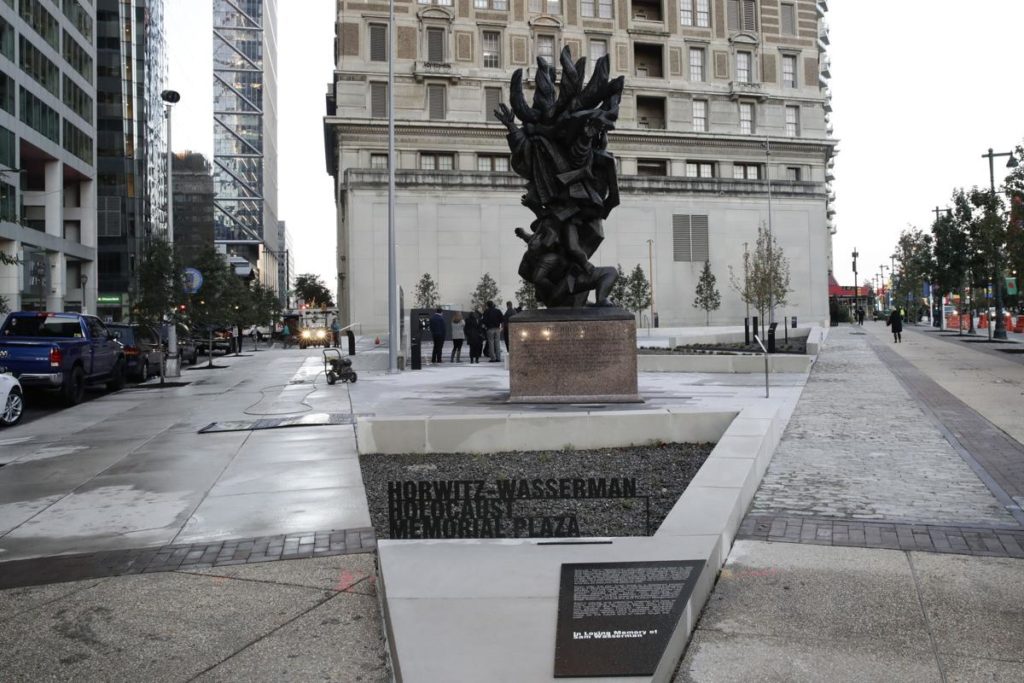In 1964, the first public memorial to the Holocaust in the United States was unveiled in a solemn ceremony in Philadelphia. The bronze-on-black granite sculpture called “Six Million Jewish Martyrs” was the work of artist Nathan Rapoport, who fled his native Poland when the Nazis invaded Warsaw. It was commissioned by a group of Philadelphia-area Holocaust survivors and Jewish civic leaders. The sculpture, which depicts images of resistance, innocence and faith, has sat unchanged on its perch along the Benjamin Franklin Parkway ever since.
Now, after more than half a century, the Holocaust Memorial Plaza has been expanded and enhanced to focus on both remembrance and education. With new displays and an interactive app, visitors can hear testimonies from survivors, liberators and witnesses associated with the Philadelphia community.
The new plaza opened Monday at a ceremony featuring local dignitaries and Holocaust survivors.
Some highlights of the expansion:
SIX PILLARS:
The plaza’s centerpiece is called the “Six Pillars.” Organized in pairs, the pillars contrast atrocities of the Holocaust with American constitutional protections and values. The idea is to remind visitors that if America is faithful to the Constitution, a genocide like the Holocaust will not happen here, said Eszter Kutas, the acting director of the Philadelphia Holocaust Remembrance Foundation.
For example, one pillar is dedicated to human equality, and features a quote from the Declaration of Independence, and is contrasted with a pillar describing the Nazis’ idea of a master race.
The six pillars feature quotes from figures like George Washington, Dwight Eisenhower and Philadelphia native and concentration camp liberator Leon Bass.
CONCENTRATION CAMP LIBERATOR, BLACK PHILADELPHIAN
Leon Bass was 20, an Army corporal who had grown up in Philadelphia embittered by the humiliation and degradation of racism. Buchenwald changed his life.
He helped liberate the Nazi death camp in April 1945, and said that for the first time, he realized that racism, and the human suffering it generates, is a universal evil.
“Some of them just wanted to touch you, be near you,” Bass recalled of the survivors in an Associated Press interview in 1985. “They stood around and just looked at you with those gaunt, deep-set eyes.”
Bass, who died in 2015 at age 90, was silent about Buchenwald for more than 20 years, opening up for the first time in 1968 when a Holocaust survivor came to speak at Benjamin Franklin High School, where he was the principal.
From that day forward, for decades, he spoke out about the atrocities he witnessed.
TRAIN TRACKS TO TREBLINKA
A portion of the original train tracks that led to the Treblinka extermination camp in Nazi-occupied Poland is embedded in the paving of the plaza.
“It’s to remind visitors of the millions of deportations that took place,” Kutas said.
The Nazis built six main death camps, all in occupied Poland: Auschwitz, Belzec, Chelmno, Majdanek, Sobibor and Treblinka. Nazis murdered an estimated 700,000 and 900,000 Jews in Treblinka’s gas chambers during the war.
The camp is perhaps the most blatant example of the “Final Solution,” the Nazi plot to rid Europe of its Jews. It was designed with the sole intention of exterminating Jews, as opposed to other facilities that had at least a facade of being prison or labor camps. Treblinka’s victims were transported there in cattle cars and gassed to death almost immediately upon arrival.
Only a few dozen prisoners managed to escape Treblinka.
SAPLING FROM THERESIENSTADT TREE
“Children imprisoned at the Theresienstadt camp received a sapling from a teacher in the camp, and nurtured it, knowing they may not see it mature,” Kutas said. Those children were later deported to Auschwitz and killed, she said, but the tree continued to thrive at the concentration camp in what was then the German-occupied Czechoslovakia.
A sapling from that tree was planted two weeks ago in the plaza, to represent life and hope for the future, “a reminder of how we must nurture our children,” Kutas said.
She said there are about half a dozen to a dozen saplings from the Theresienstadt tree planted around the world, with some in Israel, Germany, San Francisco and Chicago.
INTERACTIVE EDUCATION
The Philadelphia Holocaust Remembrance Foundation partnered with the USC Shoah Foundation to bring educational content and technology to the renovated plaza.
An app specifically developed for the plaza will allow visitors to use their mobile devices to connect to video testimonials of Holocaust survivors and witnesses. The videos will draw from the USC Shoah Foundation’s Visual History Archive that has over 54,000 eyewitness accounts of the Holocaust, along with photos, documents, maps and other educational materials.
The app will activate as a visitor moves through the plaza and will provide context and explanation of the site’s elements. Each user can tailor the app to have an age-appropriate experience.
(AP)











